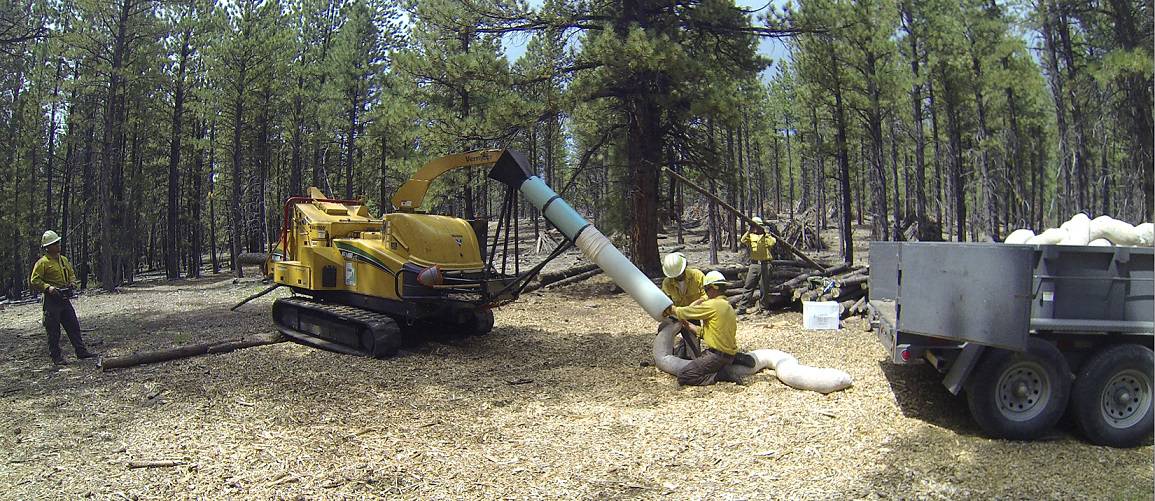Photo Credit: In 2017, the Brian Head Fire traveled through 70,000 acres of southwestern Utah. In this photo, you can see some of the post-wildfire fuels reduction work done in the burned area, in efforts to prevent future fires from entering the town of Brian Head. Photo by Mike Saemisch
Picture this: 2009, southwestern Utah. A busy interstate, with traffic coming from southern California, Canada and everywhere in between. An area that sees more than 20,000 vehicles a day. About 100 acres of dense pinyon pines and junipers separating the north and southbound lanes. Surrounding the densely vegetated island, and the interstate, is an effective, landscape-scale forest treatment project, but burning or hauling unprocessed biomass (as was done on the surrounding land) isn’t an option on the island itself. So, why not create erosion-control wattles on-site, to then be transported elsewhere?
The idea sounded crazy to the crew, but we decided to give it a try. And we were successful.

The production of erosion-control wattles, which are made from wood chips, in action. Credit: John Schmidt, Utah Division of Forestry, Fire and State Lands
To advance this project, we first altered our chipper to produce wattles. This required minimal adjustments. Then, we identified an abundant supply of the sock-like fabric we needed to encase the chips. In places like the interstate-island above, this method of on-site chipping and wattle creation has been used, sparingly, for almost 10 years now. Not only did this option help reduce the risk of wildfire in that area (a huge threat to public safety given its highly trafficked location), but the byproduct (the wattles) was able to help with erosion control after other wildfires. For example, the wattles were used on private land during rehabilitation after the 2012 New Harmony Fire.
Also about 10 years ago, near the town of Brian Head, Utah, other hand and mechanical fuels reduction projects commenced. Thick, mixed conifer stands had been plagued with pest epidemics, which led to a large buildup of fuels, declining aspen stands, and a prolific fir understory. Past efforts on private land to address similar fuel loading issues had been met with resistance. However, thanks to a cooperative landowner and an active town marshal, the much-needed work began, and more and more areas now resemble a landscape resilient to catastrophic wildfire.
By 2017, we completed a fuel break to the north of Brian Head. Once the last piles were burned, 10 acres of land was ready to reduce a wildfire back to the ground, or at least so we hoped. The local emergency services manager, Dan Benson, commented on how great it felt to have it done.
Then, the Brian Head Fire put our work to the test. About 70,000 acres later, the Brian Head Fire would become the third largest and the most expensive wildfire in Utah’s state history. Still, our fuel break worked and when paired with suppression efforts, the town was spared. Consensus was consequently strong to do more wildfire risk reduction, so that the next time (maybe 15-20 years from now) that fuel break won’t be the anomaly.
A massive interagency and private effort was launched, and continues today, that is focused on post-wildfire rehabilitation. Funding was directed to mechanical, post-wildfire fuels reduction. Our goal is to create more fuel breaks, while decreasing dense ground fuels and increasing wildlife diversity. That’s where our wattles come back in; we’ve been using those to stabilize areas that are being treated (in addition to those that were severely burned).

A feller buncher creating piles of burnt timber. Credit: Mike Saemisch
The solution of chip wattles isn’t new, but it remains helpful in many instances. The economics don’t always make sense, so that’s why it’s one option. Check out this video to see post-wildfire fuel reduction in action.
Please note that comments are manually approved by a website administrator and may take some time to appear.


We, the residents of Brian Head, were so lucky during the fire of 2017. Circumstances including wind changes and the immediate responses of fire fighting agencies and the availability of aircraft were vital but we believe that this small area of clearance saved the town. We have now begun local efforts to make our town and the surrounding areas safer from wildfires. As always, the efforts are focused on getting buy-in from others in the community so that more properties are cleaned up and prepared for the next fire threat.